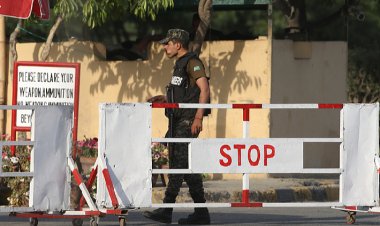Biden strikes security deal with Zelenskyy — but its future is in doubt
The move comes as President Biden aims to portray himself as the unquestioned leader of the West heading into November’s presidential election.

FASANO, Italy — The United States has extended security guarantees to Ukraine for the next 10 years, a clear effort to signal long-term support for Kyiv’s defense against Russia ahead of a U.S. election that could throw future American aid to Ukraine into doubt.
The bilateral security agreement, announced on muggy Thursday night during the G7 meeting in Italy, will see the U.S. help Ukraine strengthen its defense-industrial base, coordinate on Kyiv’s future weapons needs and inch Ukraine closer to joining NATO.
Importantly, the pact does not commit U.S. forces to enter Ukraine and defend it against Russia’s invasion. The agreement instead formalizes Washington’s current support for Kyiv for at least another decade.
But there’s a major catch: The deal is only between the current administrations of the U.S. and Ukraine and won’t be ratified by Congress. Should former President Donald Trump reenter the Oval Office in January, he could rip up the agreement, reneging on Washington’s commitment.
That makes the announcement a high-stakes gamble by President Joe Biden, who has put American credibility on the line in hopes of reassuring Ukraine and European allies, even if he can’t guarantee the deal will last 10 months –– let alone 10 years. But it could also draw a stark contrast with his Republican opponent, marking Biden as a transatlantic champion and Trump an unreliable ally.
Both leaders signed the pact before speaking to reporters Thursday, shaking hands at a table affixed with images of the U.S. and Ukrainian flags.
“A lasting peace for Ukraine must be underwritten by Ukraine's own ability to defend itself now, and to deter future aggression,” Biden said. Zelenskyy followed by stating it was “an historic day” and that the deal “benefits everyone in the world.”
Biden’s aim in Europe is to portray himself as the unquestioned leader of the West, corralling world powers to Ukraine’s side and boosting his global image ahead of the November election. The agreement both serves that purpose and demonstrates his resolve, even as a clear Ukrainian victory against Russia looks less and less likely.
The 21-page agreement includes plans ranging from how to defend Ukraine today to building a future force capable of deterring future incursions by Russia. A key element is the U.S. will further train Ukrainian troops so that Kyiv’s military further complies with Western standards needed to officially join the alliance.
“We are not waiting for the NATO process to be completed to make long-term commitments to Ukraine’s security to address the immediate threats they face and deter any aggression that may occur,” reads a fact sheet on the deal compiled by the Biden administration.
Biden and his team don’t want Ukraine in the alliance right now, even as Kyiv clamors for membership, because Russia’s continued attacks would compel American forces to directly defend Ukraine. The president has repeatedly said U.S. troops would not enter the battlefield.
Another pillar of the agreement is a commitment by the U.S. to work with Western partners to prop up Ukraine’s economy and rebuild some of its defense-industrial capabilities, which would allow Kyiv to rely less on donated weapons and more on indigenously built items. Washington will also provide technical and technological assistance to protect critical infrastructure from cyberattacks.
Should Russia push further into Ukraine, the agreement states top officials from both countries will aim to convene within 24 hours to discuss how best to safeguard Ukraine’s sovereignty.
G7 countries also are expected to announce a broad deal this week that will see $50 billion in seized Russian assets used to rebuild Ukraine, though the final details of how it will work will not be finalized in Italy. Still, that decision comes after two years of painstaking negotiations, with some European powers nervous about the legality of the move and that they’d be left guaranteeing the loan.
Ukrainian officials, while grateful, have already signaled the funds are nowhere near enough to reconstruct decimated cities and infrastructure, though Zelenskyy thanked Biden’s leadership for getting a deal done. Biden on Thursday called the agreement “a significant outcome.”
Speaking to reporters aboard Air Force One on Wednesday, national security adviser Jake Sullivan said that the money, when dispersed, would “provide the necessary resources to Ukraine now for its economic energy and other needs, so that it’s capable of having the resilience necessary to withstand Russia’s continuing aggression.”
Biden will hope these announcements, mixed with his paeans to democracy during a D-Day remembrance earlier this month, will highlight the clear differences between his and his opponent’s worldviews. Trump has long questioned U.S. support for Ukraine and European security writ large. In February, he said he’d encourage Russia to “do whatever the hell they want” to a NATO ally that doesn’t pay enough for its own defense.
Ukraine, while not a NATO member, has enjoyed a steady stream of assistance from the U.S. and its Western allies, including ammunition, artillery, air-defense systems, and much more. Two weeks ago, Biden gave Kyiv permission to use American-provided weapons to strike inside Russia, a move that would let Ukraine better defend cities and areas under direct attack.
Ward reported from Washington.












